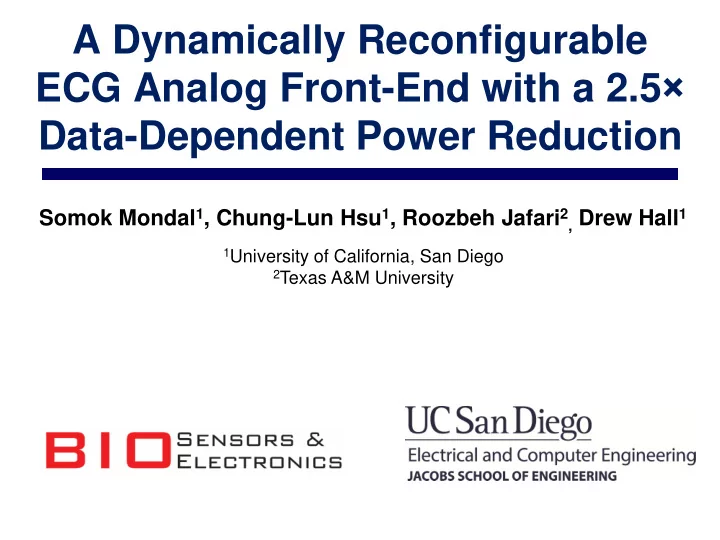

A Dynamically Reconfigurable ECG Analog Front-End with a 2.5 × Data-Dependent Power Reduction Somok Mondal 1 , Chung-Lun Hsu 1 , Roozbeh Jafari 2 , Drew Hall 1 1 University of California, San Diego 2 Texas A&M University
Outline Introduction and Motivation Adaptive Acquisition System Circuit Implementation Measurement Results Conclusion 2
Motivation World of IoTs and m-Health Miniaturized Wearable & Implantable Devices ❖ Automated, remote monitoring ❖ Early detection/diagnosis Major Challenges: • Continuous reliable monitoring via a small integrated unit • Ultra-low power interfaces with long battery life required 3
Conventional ECG Sensor Conventional low power ECG acquisition system architecture Circuit parameters: 1) Amplifier Noise 2) Amplifier Gain Overdesigned system 3) Amplifier BW FIXED! Unnecessarily high power 4) ADC Resolution 5) ADC Sampling Rate 4
Bio Signals Special properties of ECG Low activity (QRS complex over <15% of a period) Quasi-periodicity 5
Bio Signals: Data-Dependent Savings Special properties of ECG Low activity (QRS complex over <15% of a period) Quasi-periodicity Key Idea – Leverage inherent signal properties to adaptively reduce power 6
Adaptive ECG Acquisition System 7
Adaptive ECG Acquisition System Digitally assisted reconfigurable AFE Data-dependent power savings State-of-the-art low power ECG AFEs [1-2] have 𝐐 𝐁𝐍𝐐 /𝐐 𝐁𝐄𝐃 ≈ 10 [1] - Yan ISSCC’14 Focus on noise-limited [2] - Jeon ISSCC ‘14 amplifier power reduction 8
Adaptive ECG Acquisition System Digital Back-end Off-chip (FPGA) ❖ State-of-the-art low power ECG feature extraction processors [3] consume 450 nW [3] - Liu JSSC’14 9
Adaptive ECG Acquisition System Real-time Amplifier Prediction detection of power using P,Q,R,S,T reduction LMS-based peaks adaptive Dynamic filter ( using DTW reconfiguration Dynamic Time of noise modes Warping ) 10
Reconfigurable AFE: Amplifier AFE Challenges: ❖ In-band flicker noise ❖ High CMRR (for 60Hz interference) ❖ High electrode polarization offset ❖ High input impedance requirement 11
Reconfigurable AFE: Amplifier AFE Challenges: ❖ In-band flicker noise ❖ High CMRR (for 60Hz interference) ❖ High electrode polarization offset ❖ High input impedance requirement 12
Reconfigurable AFE: Amplifier AFE Challenges: ❖ In-band flicker noise ❖ High CMRR (for 60Hz interference) ❖ High electrode polarization offset ❖ High input impedance requirement 13
Reconfigurable AFE: Amplifier Noise Reconfiguration: OTA Topology Selection Single-tail vs. Dual-tail OTA ❖ Constant CM for wide current ❖ CMFB issue – open loop gain changes with current 14
Reconfigurable AFE: Amplifier Noise Reconfiguration: ❖ Wide current tuning range (100 nA – 675 nA) ❖ Better noise efficiency 15
Reconfigurable AFE: ADC Reconfigurable AFE: ADC SAR ADC Reconfiguration: ❖ Sampling rate ❖ Resolution 9-bit Mode: 7-bit Mode: 16
Digital Back-End Functionality LMS-based Adaptive Linear Predictive Filter 𝑦[𝑜] : Detected R-R interval, 𝑧 𝑜 : Predicted R-R interval, 𝑥 𝑗 : Adaptive-filter coefficients, 𝜈: Adaptation parameter. 17
Digital Back-End Functionality LMS-based Adaptive Linear Predictive Filter ❖ Prediction independent of the feature- extraction algorithm (e.g., DTW) ❖ 5 th order filter sufficiently accurate for quasi-periodic ECG with typical heart-rate variability (HRV) 18
Digital Back-End Functionality LMS-based Adaptive Linear Predictive Filter ❖ One prediction per heart beat (72 beats/min) ❖ Operation at ~1 Hz ❖ Simulated < 10nW power Negligible power overhead for reconfiguration! 19
Noise Power Trade-off Measured amplifier input-referred noise 20
Data-Dependent Power Savings 2.5 × data-dependent power reduction! 21
Adaptive Acquisition Performance Performance characterized using ECG data from MIT-BIH Arrhythmia database False prediction due Filter quickly adapts to to abrupt variability make correct predictions ❖ Power savings over prolonged duration of slow HRV ❖ Recurring false prediction with extreme irregular cardiac activity is itself an indicator of an anomaly No compromise in anomaly detection capability! 22
Adaptive Acquisition Performance Δ t – Peak positions in data acquired adaptively relative to that when AFE is always in high power mode T avg – Avg. separation between consecutive peaks < 0.35% in extracted signal metrics of interest! 23
Performance Comparison Demonstrated activity-dependent amplifier power savings! 24
Conclusion Dynamic noise-power trade-off in amplifier Aided by LMS filter with negligible power overhead Data-dependent signal acquisition demonstrated to achieve 2.5 × power reduction Useful technique particularly for IoT mHealth applications Acknowledgements : UCSD Center for Wireless Communication (CWC) for student support and SRC for chip fabrication. 25
Recommend
More recommend